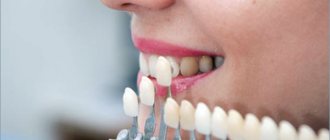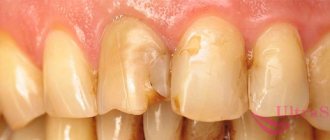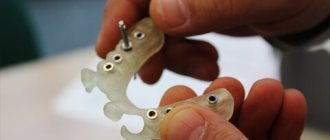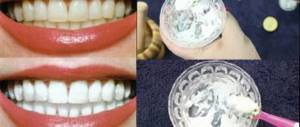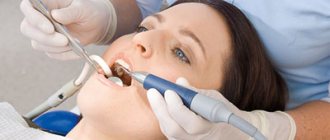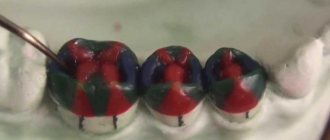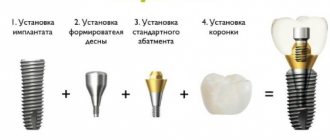If you need to make room before installing orthodontic Invisalign aligners, braces or dentures so that each tooth is in the correct position, separation (interproximal enamel reduction) is performed. The operation is painless, bloodless, minimally traumatic, does not require long-term rehabilitation, but can lead to complications if performed incorrectly on the patient.
Types and implementation
There are approximal (lateral) and coronary-radicular separation. The first is the prerogative of aesthetic dentistry, and the second is of curative dentistry.
The process of lateral separation consists of removing a layer of enamel, no more than ¼ millimeter thick, from the sides using special tools. If several molars are separated, sufficient space is created for further orthodontic manipulations. Grinding of tooth enamel is non-traumatic and painless.
Coronary-radicular separation is used for double-rooted units, when the tooth is divided in half, sparing the affected area between the roots. In this way, tooth extraction is avoided and its base is preserved for further prosthetics.
According to the specifics of the equipment for this procedure, the following types of separation are distinguished:
- Mechanical. In this case, the doctor uses abrasive burs, diamond burs, files, single-sided and double-sided discs to grind the enamel of bone organs.
- Physiological. Between the patient's teeth, the doctor fixes separation devices (wedges or threads), which remain in the interdental space for some time (usually a day, then a rearrangement is made).
In both cases, the goal of the procedure is achieved - moving the units apart and creating additional space between them. The mechanical procedure is more popular due to its accuracy and speed.
Classic separation ends with grinding of sharp corners and applying protective adhesive.
Important! All types of separation, at the request of the patient, are carried out using local anesthesia. Although the procedure is not as painful as it seems.
Separation is a humane alternative to removal
Dentists call separation a simple procedure that involves removing a thin layer of enamel from the side surfaces of a group of teeth. On one side, enamel with a thickness of only 0.25 mm is removed, which does not affect the health of the tooth or its aesthetic characteristics, but sometimes leads to increased sensitivity. This method has been practiced since the 1960s and is still justifiably considered painless and harmless.
- Of course, a quarter of a millimeter won't make a difference. But on one tooth, when processing two faces, it is possible to save 0.5 mm, and on 6 and 10 teeth, respectively, 3 mm and 5 mm. These missing millimeters already allow the orthodontist to plan the optimal program for correcting the bite with braces.
- In addition, in many patients, the crowns have a trapezoidal shape, widened downwards, towards the gums or, conversely, upwards. After separation, they take on a correct, almost rectangular shape, and subsequently, by the time the treatment is completed, the gaps near the gums close.
However, dentists often have to deal with separation failure. Tooth extraction under anesthesia frightens some patients much less than a simple, painless procedure to remove a minimal layer of dental tissue. Let's figure out what the advantages of this method are.
Advantages
The main advantage and benefit of separation is the ability to preserve the tooth while providing sufficient space for maxillodental corrections, avoiding extraction (removal) even with very complex anomalies.
It is this method that allows you to very accurately calculate the size of the space required for correction.
No less significant advantages are:
- speed and relative painlessness;
- clear control of the formed interdental space;
- the ability to free up up to 8 mm of space on one jaw without depriving the patient of healthy teeth;
- no need to carry out any rehabilitation measures;
- safety and painlessness, but only if the procedure is performed by a highly qualified specialist.
Important! Separation is not always a panacea. In some cases, it is necessary to sacrifice a premolar, but this must be decided by the doctor.
Indications for orthognathic surgery and its cost.
We will discuss here in what situation a consultation with an orthodontist is necessary.
At this address https://orto-info.ru/ortodonticheskoe-lechenie/podgotovitelnyiy-period/metodyi-diagnostiki.html we will tell you what diagnostic methods exist in orthodontics.
The result of treatment by an orthodontist
As a result of the treatment, normalization of the shape of the dentition was achieved, and protrusion of the frontal group of teeth was eliminated.
The smile has become beautiful, the facial profile is ideal from all angles.
The cost of the orthodontic treatment was 170,800 rubles.
The duration of treatment is 14 months.
Flaws
The procedure has no disadvantages. Many people are scared by the very fact of removing a layer of enamel, however, it is so small that the patient does not even notice the difference before and after the procedure.
The thickness of the enamel reaches 2 millimeters and removal of less than 0.25 millimeters has virtually no effect on its density.
Numerous clinical trials confirm that after the procedure the enamel remains strong and externally undamaged.
During mechanical separation with a bur, the subdental areas of the gums can be damaged; to minimize this possibility, special retainers are used.
With proper preparation for separation, there should be no complications. The main thing is that the procedure must be carried out by a specialist, observing all the necessary requirements.
Important! Before the procedure, it is necessary to treat all teeth and sanitize the oral cavity, achieving maximum destruction of pathogenic flora.
Content:
- Who is recommended for teeth straightening with braces?
- Preparing to align rows with braces
- Installation of braces
- Wearing braces during teeth straightening
- Removing the leveling device
- How long to wear braces
- When alignment with braces is not possible
How do braces straighten teeth? They do not do this by themselves, since in reality they play only a secondary role. After all, the term “braces” hides tiny locks that are responsible for holding the metal arch. It is the latter that does all the leveling work - moves the curved units and forces them to take the correct positions. But it just so happened that the entire orthodontic structure was named after the miniature locks.
Possibility of complications
Complications during enamel grinding can only arise if the dentist makes a mistake or is insufficiently qualified, namely:
- death or damage to the pulp (tooth cavity);
- increased tooth sensitivity after the procedure;
- inflammation of the gum tissue when it is injured.
Important! Before the procedure in a reputable clinic, the patient will be asked to take an X-ray of the jaw in order to exclude individual deviations in the structure and location of the dental pulp, and not damage it during separation.
Important! By paying attention to the fixation of the doctor’s hands, the patient can himself draw a conclusion about his qualifications. When grinding a tooth, the professional fixes his right hand with the tip of the drill machine on the patient’s chin.
This position gives maximum precision when grinding. The doctor holds a dental mirror in his left hand and, by pushing back the soft tissues of the cheek, ensures that the procedure is not traumatic.
An increase in the reaction of teeth to hot and cold after the procedure is extremely rare in patients. An experienced dentist would not recommend this procedure for a client with demineralized thin enamel.
Rather, he will first recommend a course of intensive restoration of the enamel structure, and only then will consider the possibilities of separation or the use of other methods for correcting maxillodental anomalies.
Indications
The advisability of using this procedure, which is gentle on teeth, is determined by the orthodontist, taking into account the general condition of the bone organs and the degree of necessary correction. General indications for separation:
- malocclusion;
- projecting or triangular anterior units;
- too dense dentition;
- crowding;
- erasing the cutting edge;
- installation of veneers;
- installation of bracket systems;
- indications for implantation.
When you need additional space between your teeth, go ahead with the procedure! But first, consult your favorite doctor.
How and with what is teeth separated for braces?
To process the protruding parts of the tooth, strips are used - special abrasive strips, or a thin fine-grained bur. It is believed that the latter provides greater accuracy and is more gentle on the patient.
But in practice, it turns out that the result is still determined by the skill of the orthodontist and the degree of coordination of his interaction with the assistant. When performing sedation, the nozzle must be firmly fixed, and at the same time it is necessary to protect soft tissues from injury using a mirror. Therefore, there is nothing to worry about if the teeth are carefully ground down when installing turnkey braces using strips. After roughing, the doctor will carefully sand all sharp areas.
But a physiological separation technique is also used. Separation wedges are placed in the gaps between certain teeth and fixed for a day. They provide the minimum space required by the orthodontist.
Recommendations
After the procedure, as mentioned earlier, no special restorative manipulations are required.
After grinding your teeth, you can apply a special glue to the enamel to protect it. At the patient's request, it is possible to undergo a course of enamel mineralization. Ask a doctor - he will tell you.
There’s no need to remind you, but we’ll remind you anyway. General recommendations for patients:
- It is necessary to undergo regular dental examinations, at least once a year;
- monitor the condition of the oral cavity (no one has canceled hygiene);
- rinse your mouth after eating foods with pigmented agents (coffee, tea, bright berries and juices, beets, etc.), especially if whitening is done;
- do not use your teeth for other purposes (there are bottle openers and nut crackers in the world) and give up the habit of grinding your teeth;
- don't forget about floss. The main enemy of our bone organs is bacteria in food debris between the teeth.
Teeth are not hair; they won’t grow back a second time. A caring attitude is the key to a healthy and beautiful smile for a successful person.
The purpose of dental wax for braces and whether to ignore its use.
In this article we will talk about correcting malocclusion in adults surgically.
Follow the link https://orto-info.ru/ortodonticheskoe-lechenie/osnovnoy-period/stomatolog-chto-jetot-vrach.html if you are interested in what a pediatric orthodontist treats.
Installation of braces
When the patient's oral cavity is prepared for orthopedic therapy, he is invited to an appointment. Most often, retaining clasps are fixed in a direct way, that is, they are glued separately to each unit. But with the advent of modern dental technologies, doctors can also use an indirect fixation method - through mouth guards.
The standard procedure takes about one and a half hours and is carried out according to the following scheme:
- removing tartar using an ultrasonic scaler;
- washing and drying crowns;
- application of primer and adhesive;
- alternate gluing of locks;
- removing excess adhesive from the surface of dental crowns;
- light polymerization.
When gluing locks, it is important to leave just enough adhesive on the enamel as needed. If there is too much of it, it will come out from under the metal bases and will become colored with food coloring over time. Then the space surrounding the castles will become gray and spoil your smile.
If you remove too much of the cured compound, large gaps will form between the braces and the enamel. Food will begin to accumulate in them, and pathogenic microorganisms will begin to multiply. And this is a direct path to caries and related complications.
How much money do you need
Not a single decent clinic will calculate the cost of treatment for a patient over the phone. The total cost to a patient depends on many factors:
- scope of diagnostics;
- need for x-rays;
- the scope of the work itself;
- application of anesthesia and other services.
The region of residence of the patient and the qualifications of the doctor are important.
If you decide to take care of your loved one, look for a clinic in your city, choose a doctor who inspires your trust, and start working on improving your appearance. And then - there is no limit to perfection!
Separation prices
The cost of the service, of course, depends on the chosen method. But if we are talking about the grinding or stripping method, then the price is announced for one processed unit. Usually it fluctuates around 500 rubles. Depending on the region, the cost may increase or, conversely, be less.
If you are still intimidated by the prospect of machining, read the reviews of those who have already completed this stage. People successfully completed treatment without unnecessary removal. Based on this, it can be understood that the technology of enamel recontouring is truly a gentle procedure with minimal impact and enormous therapeutic potential.
Forecast
When going to the dentist’s office, the patient hopes for comfortable and high-quality treatment, the doctor’s understanding and the desire to make every effort to restore and preserve the client’s teeth.
Separation is not yet a widely accepted tooth-preserving method for correcting defects of the maxillofacial region. However, when there is a shortage of space for adjacent units, this is the most effective way to obtain it.
For information on the separation of interdental spaces, watch the video.
